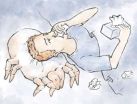(Press-News.org) Athens, Ga. – Scientists have long known that providing supplemental food for wildlife, or resource provisioning, can sometimes cause more harm than good. University of Georgia ecologists have developed a new mathematical model to tease apart the processes that help explain why. Their research, which has implications for public health and wildlife conservation, appears in the Royal Society journal Biology Letters.
Wildlife of many kinds are increasingly finding their meals in human environments, gathering at places like backyard bird feeders, landfills or farms that offer an easily accessible year-round source of food. As with people, however, when large numbers of animals congregate they can face a higher risk of contracting disease. A number of studies have found large disease outbreaks following the introduction of supplemental food resources, as in the case of Hendra virus in flying foxes in Australia. Others have shown just the opposite, with disease transmission slowed or eliminated, as with gut parasites in macaques in Bali.
A desire to understand this puzzling disparity in disease outcomes motivated the study by Daniel Becker, a doctoral student in the Odum School of Ecology, and co-author Richard Hall, assistant research scientist in the Odum School and the College of Veterinary Medicine department of infectious diseases.
"This activity is important for wildlife conservation and human health," said Becker. "There are more and more examples of provisioning affecting disease risk. By creating resource hot spots, we're essentially providing opportunities to bring together wildlife, domestic animals and humans, offering chances for pathogens to spread between species."
Providing food for wildlife—whether intentionally, as with bird feeders or feeding stations for feral cat colonies, or unintentionally as in the case of garbage dumps—can cause changes to an animal's breeding success, foraging behavior and body condition that in turn influence its risk of acquiring harmful infections.
A steady, easy-to-access source of nutrition can increase the size of a wildlife population by improving reproductive success and increasing animals' life spans. A larger pool of uninfected—and therefore susceptible—animals can fuel disease outbreaks and increase the chance that the population remains infected over longer timescales.
Furthermore, gathering around feeding stations leads to more contacts between animals, increasing the chances that sick individuals will pass on their infection to others.
Easy access to food also improves body condition, allowing animals to mount more effective immune defenses. This can reduce infection levels in wildlife by allowing animals to successfully fight off pathogens before they become infectious. Conversely, if improvements to immune defense cause sick animals to live longer, they may pass on infection to more individuals throughout their lifetime.
"You've got these opposing processes, with factors such as aggregation and larger population sizes potentially aiding disease spread, and improved ability of animals to resist infection making it harder for the disease to spread," said Hall.
"Figuring out how these all work together to influence population-level disease outcomes isn't really straightforward," added Becker. "It helps having a formal model to look at how these processes together all play out."
For their model, Becker and Hall used data from studies of feral cats with feline leukemia virus that visited supplemental feeding stations. They looked at how birth rate, death rate, contact rate and the strength and speed of immune system response were influenced by the amount of supplemental food the animals were able to access.
The model revealed that a key factor in predicting disease outbreaks in wildlife that access supplemental food was how that additional food influenced the strength and speed of the immune response. And more food wasn't necessarily better. Under some scenarios, even low levels of supplemental food could increase the risk of outbreaks compared with wild-feeding populations. In other cases, a small amount of supplemental food initially drove down infection levels, but too much led to the population size growing so large that the increased opportunities for infection to spread overcame the animals' immune defenses, with large outbreaks possible.
The authors said that their results point to the urgent need for more field and laboratory studies to explore the relationship between resource provisioning, immune defense and disease.
"As the planet becomes more urbanized, wildlife are increasingly coming into cities to use these resources, and then they can come into contact with domestic animals and humans, with potentially the risk of infections spilling over across species," Hall said. "For people who put out food for birds, wildlife or free-roaming feral cats, it's important to understand that supplemental feeding can have these unintended consequences of enhancing disease transmission."
He advised that if people notice sick animals at their feeding stations, the best course of action is to remove the food source to allow the uninfected animals to disperse, and to clean feeders regularly and thoroughly.
Providing supplementary food is also a frequent management action as part of recovery plans for rare and threatened wildlife, but Becker and Hall urged caution before applying this strategy in species vulnerable to diseases causing high mortality, such as rabies.
"We really need to do more research to figure out how immune response depends on supplementation," Hall added. "The modeling study illuminates where we should be focusing experimental efforts."
INFORMATION:
The full research article is available at http://rsbl.royalsocietypublishing.org/lookup/doi/10.1098/rsbl.2014.0309. A UGA Graduate Research Assistantship and a National Science Foundation Graduate Research Fellowship supported this study.
UGA Odum School of Ecology
The UGA Odum School of Ecology, the world's first stand-alone school dedicated to ecology, is creating the future of ecological discovery through innovative research about the rapidly changing planet, educating the next generation of ecologists and applying knowledge in service to the broader public. For more information, see http://www.ecology.uga.edu.
Contact: Daniel Becker, 706-542-3485, dbecker@uga.edu
Richard Hall, 706-542-3971, rjhall@uga.edu
New model helps explain how provisions promote or reduce wildlife disease
2014-07-23
ELSE PRESS RELEASES FROM THIS DATE:
In asthma, it's not just what you smell, but what you think you smell
2014-07-22
PHILADELPHIA (July 22, 2014) – New research from the Monell Center reveals that simply believing that an odor is potentially harmful can increase airway inflammation in asthmatics for at least 24 hours following exposure. The findings highlight the role that expectations can play in health-related outcomes.
"Asthmatics often are anxious about scents and fragrances. When we expect that an odor is harmful, our bodies react as if that odor is indeed harmful," said study lead author Cristina Jaén, PhD, a Monell physiologist. "Both patients and care providers need to understand ...
The dopamine transporter
2014-07-22
Recent published research in the Journal of Clinical Investigation demonstrates how changes in dopamine signaling and dopamine transporter function are linked to neurological and psychiatric diseases, including early-onset Parkinsonism and attention deficit hyperactivity disorder (ADHD).
"The present findings should provide a critical basis for further exploration of how dopamine dysfunction and altered dopamine transporter function contribute to brain disorders" said Michelle Sahai, a postdoctoral associate at the Weill Cornell Medical College of Cornell University, ...
Alaska frogs reach record lows in extreme temperature survival
2014-07-22
Freezing and thawing might not be good for the average steak, but it seems to help wood frogs each fall as they prepare to survive Alaska's winter cold.
"Alaska wood frogs spend more time freezing and thawing outside than a steak does in your freezer and the frog comes back to life in the spring in better shape than the steak," said Don Larson, University of Alaska Fairbanks graduate student and lead author on a recent paper demonstrating that freeze tolerance in Alaska wood frogs is more extreme than previously thought.
Although wood frogs are well-studied freeze-tolerant ...
Study examines presence of uterine cancers at the time of hysterectomy using morcellation
2014-07-22
Among women undergoing a minimally invasive hysterectomy using electric power morcellation, uterine cancers were present in 27 per 10,000 women at the time of the procedure, according to a study published by JAMA. There has been concern that this procedure, in which the uterus is fragmented into smaller pieces, may result in the spread of undetected malignancies.
Despite the commercial availability of electric power morcellators for 2 decades, accurate estimates of the prevalence of malignancy at the time of electric power morcellation (in this study referred to as morcellation) ...
The 92 percent clean plate club
2014-07-22
If you're a member of the Clean Plate Club – you eat pretty much everything you put on your plate – you're not alone! A new Cornell University study shows that the average adult eats 92% of whatever he or she puts on his or her plate. "If you put it on your plate, it's going into your stomach," says Brian Wansink Ph.D., author of the forthcoming book, Slim by Design, Professor of Marketing and Director of the Cornell Food and Brand Lab.
Wansink and co-author Katherine Abowd Johnson analyzed 1179 diners and concluded that we're a Clean Plate Planet. Although diners ...
Essays in English yield information about other languages
2014-07-22
Computer scientists at MIT and Israel's Technion have discovered an unexpected source of information about the world's languages: the habits of native speakers of those languages when writing in English.
The work could enable computers chewing through relatively accessible documents to approximate data that might take trained linguists months in the field to collect. But that data could in turn lead to better computational tools.
"These [linguistic] features that our system is learning are of course, on one hand, of nice theoretical interest for linguists," says Boris ...
NASA's Fermi finds a 'Transformer' pulsar
2014-07-22
VIDEO:
Zoom into an artist's rendering of AY Sextantis, a binary star system whose pulsar switched from radio emissions to high-energy gamma rays in 2013. This transition likely means the pulsar's...
Click here for more information.
In late June 2013, an exceptional binary containing a rapidly spinning neutron star underwent a dramatic change in behavior never before observed. The pulsar's radio beacon vanished, while at the same time the system brightened fivefold in gamma rays, ...
Forty-five percent rise in diagnostic imaging tests by GPs -- new study
2014-07-22
A 45 per cent rise in diagnostic imaging tests ordered by Australian GPs is being driven by increasing GP visits, a rising number of problems managed at consultations and a higher likelihood that GPs order imaging tests for these problems, according to a new University of Sydney study released today.
Based on a long term national survey of 9,802 GPs between 2002 and 2012, the report draws on data from more than 980,000 GP-patient encounter records to assess the extent to which GP's order tests in line with diagnostic imaging guidelines.
"Most imaging tests ordered by ...
Gene variant identified as a heart disease risk factor for women
2014-07-22
When it comes to heart disease, Dr. Ross Feldman says women are often in the dark. Historically, it was thought that heart disease was a men's-only disease, however, data has shown that post-menopausal women are just as likely as men to get heart disease and are less likely to be adequately diagnosed and treated. New research from Western University published online this week in the British Journal of Clinical Pharmacology brings to light a genetic basis for heart disease in women and helps to identify which women are more prone to heart disease.
The study, led by Dr. ...
Researchers create vaccine for dust-mite allergies
2014-07-22
If you're allergic to dust mites (and chances are you are), help may be on the way.
Researchers at the University of Iowa have developed a vaccine that can combat dust-mite allergies by naturally switching the body's immune response. In animal tests, the nano-sized vaccine package lowered lung inflammation by 83 percent despite repeated exposure to the allergens, according to the paper, published in the AAPS (American Association of Pharmaceutical Scientists) Journal. One big reason why it works, the researchers contend, is because the vaccine package contains a booster ...




